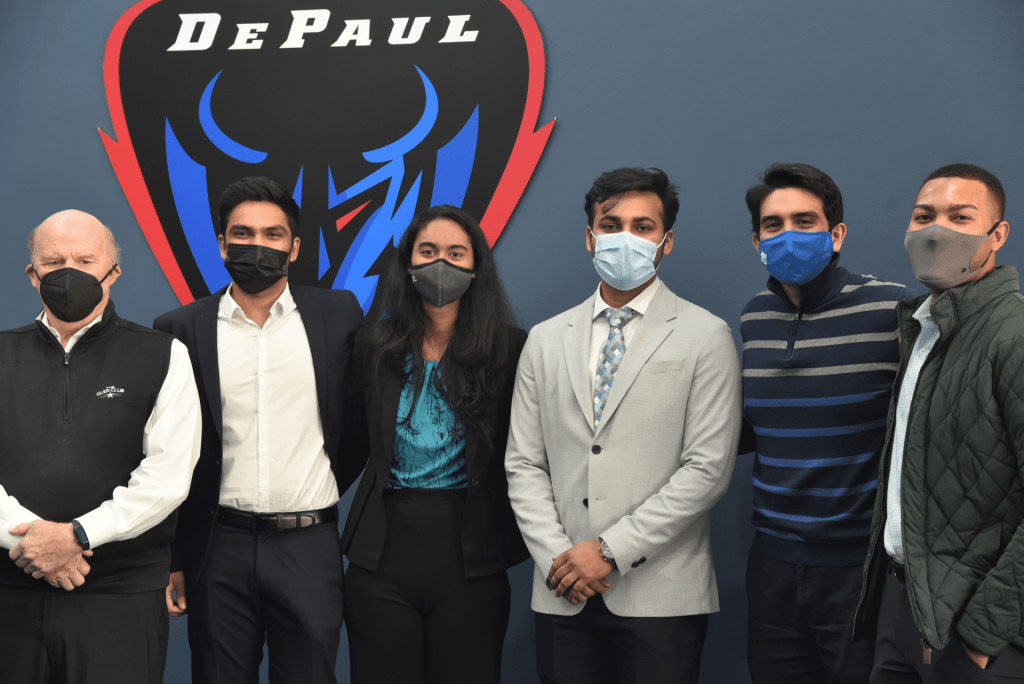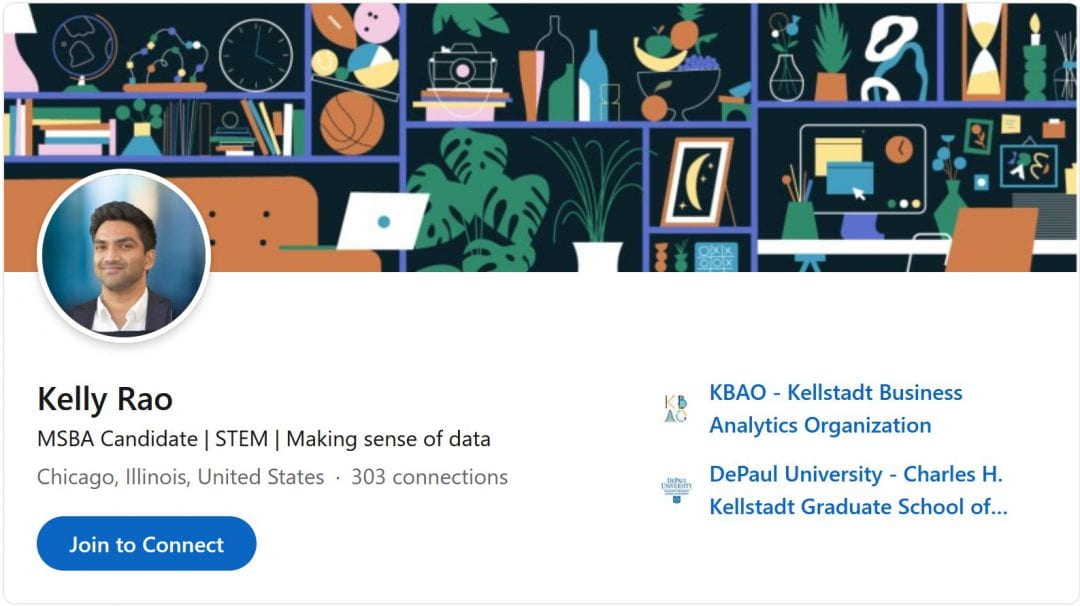By Kelly Rao
We are all looking for that magic formula, one that helps us stand out to recruiters and makes us look good in front of colleagues on LinkedIn. Truth be told, there isn’t just one but many different templates for success when it comes to managing your online professional presence.
LinkedIn is often the centerpiece of your online professional persona and the first point of reference for employers to verify your credibility. It is also a tool that can help you build relationships and create new opportunities for yourself. At a recent event held by Kellstadt Business Analytics Organization (KBAO), we brought in experts from the Kellstadt Career Management Center to help students fine-tune their LinkedIn presence and provide students with the opportunity to take a professional LinkedIn headshot. Our key takeaways from the event included developing your brand, leveraging LinkedIn’s ecosystem and being proactive about building relationships.

KBAO faculty advisors and student board members at the LinkedIn event that KBAO hosted in the fall (left to right): Don Patchell, instructor and director of the MS in Business Analytics Program; Kelly Rao, president; Rudhra Seetharam, vice president of public relations; Shoeb Ahmed, vice president of strategy; Sina Ansari, assistant professor of management and entrepreneurship; Chris Lai, treasurer.
Create a Profile that Reflects Your Brand
Building a brand can be difficult, especially when you aren’t sure of what exactly you want to do. A brand isn’t necessarily your job title or function but a snippet of what you hope to accomplish. Your photo and headline in LinkedIn are the most important aspects of your profile that can help build your brand. If you think of yourself as a business, these would be your company name, logo and mission statement. This information often determines whether a recruiter who finds you through LinkedIn will click on your profile.
To create a great first impression, your headline should include what you currently do, as well as keywords related to your industry or professional aspirations. Also consider including a unique accomplishment you feel is valuable.
When it comes to the “About” section, tell the audience your unique story. Instead of making generic and cliché statements like “I am a critical thinker,” try to provide an instance where you developed that skill. For example, “When working at X, I had to dig deep and develop my critical thinking skills to solve XYZ.” Being specific in this section and creating a well-crafted narrative will make your profile engaging and memorable. The “About” section is where you describe only you and not anyone else.
The idea of crafting a narrative extends to other sections of your LinkedIn profile, such as your experience section. The most common assumption about this section is that you include all your work experience and simply state your job descriptions in each one of them. For more experienced professionals, this can lead to information overload on their profiles. And for those with not much experience, this can be limiting.
There is no single template for success; how you arrange your experiences will depend on the narrative you want to craft. If you have too many experiences, think about omitting those that are less relevant to your narrative. The same way you would for a résumé, select your experiences for the job you want. If you are facing the opposite problem, and your profile looks sparse, consider including volunteer experience and other non-professional experience. If you’re a student, don’t be afraid to include your relevant classes if you need to fill the section out. Classes are valuable experience and if you can articulate what you did in a class, you can sell yourself to a recruiter who decided to look you up.
Being intentional about what you choose to include in your profile could be the difference between landing an opportunity or getting a rejection email. While your profile may reflect your goals at this point, it is good practice to review it every few months to make sure it still reflects your goals.
Leverage LinkedIn’s Tools and Features
Many of us know LinkedIn as the platform to display our professional record and build our network, but few explore what it can do beyond this. There are countless ways to maximize your presence on LinkedIn through features such as Interview Prep, Skill Assessments and LinkedIn Learning. These are just a few of the many tools on the platform.

LinkedIn Learning is one of my favorite features, but to call it a feature is a bit reductive. It is a distinct platform that competes with other educational sites such as Coursera, Udemy and edX. What separates it from its competitors is its tight integration with LinkedIn and its wide-range of practical course offerings, many of which require a minimal time commitment of just two hours. And, it is free for DePaul students when you link your depaul.edu account.
Completing courses and displaying them on your profile can be valuable, but another way to showcase your skills is by using the Skill Assessment feature, which allows you to take a short quiz and test your knowledge on software tools or business concepts. If you score in the top percentile, you are awarded with a skill badge you can put on your profile.
Lastly, LinkedIn Interview Prep can help you find templates for general interview questions and guide you on what works and why. If you frequently include LinkedIn jobs as part of your job search, consider using your free trial of LinkedIn Premium to get access to detailed interview prep questions and answers. Be aware, however, that this resource does not include job-specific technical questions; it is more of a higher-level view.
Engage and Connect
One of the best ways to advertise yourself on LinkedIn and build your network is by consistently engaging with content that’s relevant to your brand. But make sure to do this mindfully because LinkedIn displays posts your connections interact with, and this can be a pro or con depending on how frequently you engage.
Reaching out to people to make connections is another great way to gain exposure. Just make sure you explain why you are reaching out and what’s in it for them, especially when you’re doing cold outreach. Being vague will likely garner a poor response rate. Assume the person is busy and ask specific closed questions they are likely to know rather than open-ended questions that require some investigation. Questions that focus on the person go a long way and shows them you are interested in them as a professional beyond what they can offer you.
Whether it is building your brand, making the most of LinkedIn’s tools or connecting with people, keep in mind that managing your LinkedIn presence is a marathon, not a sprint. Start early, be consistent and results will follow. If you’ve done everything right but still can’t seem to gain traction, reach out for advice. The Kellstadt Career Management Center is a good place to start, but there are also many career coaches familiar with LinkedIn, and they are just a connection away.
Are you a graduate student at DePaul interested in analytics? Join KBAO, and follow us on Instagram and LinkedIn for upcoming events.
 Kelly Rao is an MSBA candidate at the Kellstadt Graduate School of Business, president of Kellstadt Business Analytics Organization (KBAO) and proud blue demon with a BS in Management Information Systems from DePaul University. In addition to his involvement in student organizations, Kelly is a data visualization enthusiast and active volunteer in non-profit data projects. In his free time, you can find him at the bouldering gym, on the tennis court or at the Riverwalk listening to a podcast.
Kelly Rao is an MSBA candidate at the Kellstadt Graduate School of Business, president of Kellstadt Business Analytics Organization (KBAO) and proud blue demon with a BS in Management Information Systems from DePaul University. In addition to his involvement in student organizations, Kelly is a data visualization enthusiast and active volunteer in non-profit data projects. In his free time, you can find him at the bouldering gym, on the tennis court or at the Riverwalk listening to a podcast.



Recent Comments